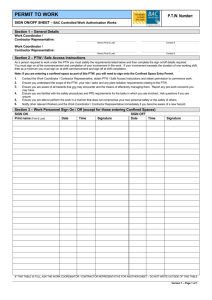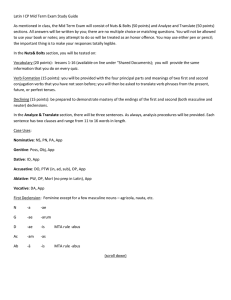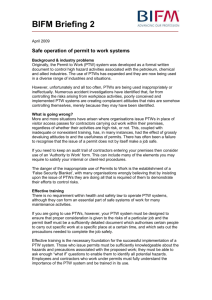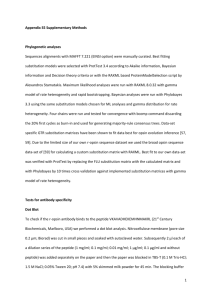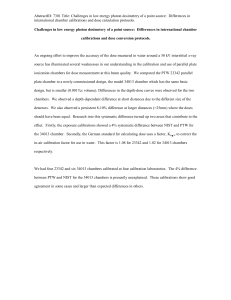Using AVI data to understand powered-two
advertisement
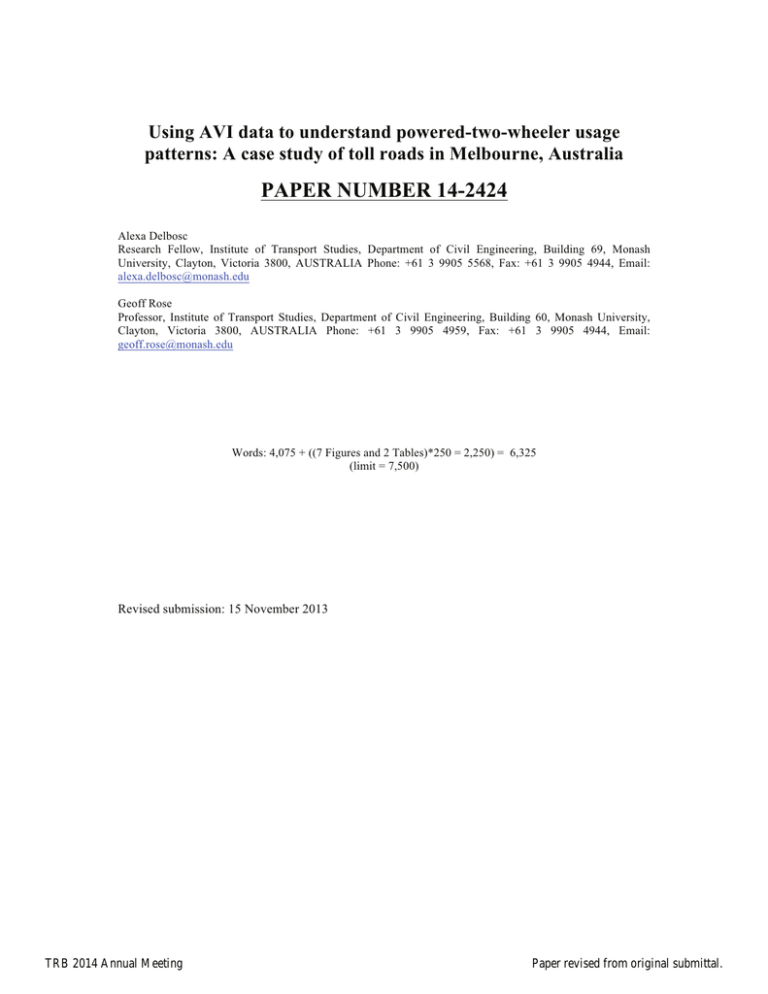
Using AVI data to understand powered-two-wheeler usage patterns: A case study of toll roads in Melbourne, Australia PAPER NUMBER 14-2424 Alexa Delbosc Research Fellow, Institute of Transport Studies, Department of Civil Engineering, Building 69, Monash University, Clayton, Victoria 3800, AUSTRALIA Phone: +61 3 9905 5568, Fax: +61 3 9905 4944, Email: alexa.delbosc@monash.edu Geoff Rose Professor, Institute of Transport Studies, Department of Civil Engineering, Building 60, Monash University, Clayton, Victoria 3800, AUSTRALIA Phone: +61 3 9905 4959, Fax: +61 3 9905 4944, Email: geoff.rose@monash.edu Words: 4,075 + ((7 Figures and 2 Tables)*250 = 2,250) = 6,325 (limit = 7,500) Revised submission: 15 November 2013 TRB 2014 Annual Meeting Paper revised from original submittal. Delbosc and Rose Abstract Australia’s cities are facing increasing concerns over traffic congestion and pollution which has encouraged an interest in sustainable transport choices. Most of the focus of this concern has been on cars, public transport and active transport; in contrast, the role of powered two-wheelers (PTW), specifically motorcycles and motor scooters, has received relatively little attention. The majority of research on PTWs focuses on the road safety implications, with relatively little known about patterns of usage. This paper presents the results of an analysis of Automatic Vehicle Identification (AVI) counts at two major tolled freeways in Melbourne: one radial freeway close to the city centre and one orbital freeway 20 to 30km southeast of the city centre. Automatic vehicle classification equipment recorded hourly traffic counts and PTW counts from 2006 to 2012. The paper presents an analysis of the classified count data to explore the pattern of PTW use by time of day, day of week and across the seasons. Weather effects are examined using regression analyses. Comparisons are drawn between PTW and non-PTW traffic and between the radial and orbital freeways. The paper concludes with a discussion of the findings and suggestions for future research. 2 TRB 2014 Annual Meeting Paper revised from original submittal. Delbosc and Rose INTRODUCTION The rapid growth in motor vehicle ownership and use in urban areas has seen increasing concerns over congestion, safety, availability of energy sources and environmental issues such as pollution and climate change. The transport profession has responded through the development of a range of supply and demand measures to enhance the sustainability of the transport system. Most of the attention in the context of sustainable mobility is however focussed on the motor car [1] with relatively little attention given to motor cycles and motor scooters. Increasingly the term Powered-Two-Wheel (PTW) vehicle is being used cover a range of two or three wheel vehicles from mopeds (low power motor cycles typically with engines less than 50cc and usually with a maximum speed of 50 kph) to motor scooters and motorcycles [2]. The opportunities which PTW vehicles present from the perspective of sustainable transport have not been investigated in detail [3]. Research on PTW vehicles often has a road safety focus because these vehicles are over represented in crash statistics. Fatality rates for PTW riders have been found to be 20 to 40 times for car occupants per distance travelled [4-6]. When seeking to understand differences in crash rates across different types of vehicles, information on exposure is critical. It is often a challenge to quantify exposure in PTW road safety studies because of historically low response rates to surveys of PTW riders [7]. Traffic engineers have studied general traffic patterns for many years [8], and classified traffic counts are commonly conducted for short duration studies. However PTW vehicles are rarely considered, apart from in South East Asian countries where ownership per capita is much higher than in Australia [7] and PTWers can account for 80 per cent or more of the vehicles on major roads [9]. The growth in deployment of automatic traffic counting equipment has made it possible to study usage patterns in modes that have historically received relatively little attention in the literature. For example, installation of automatic counters on bicycle paths has made it possible to develop much richer understanding of bicycle usage patterns and the impacts of weather on bicycle ridership [10, 11]. The research reported here lays foundations for the development of similar understanding of PTW usage patterns. The aim of this research is to enhance understanding of the temporal patterns of PTW vehicle usage. The study relies on data obtained from automatic classification equipment on two tollways in Melbourne, Australia. The availability of multi-year data facilitates the examination of temporal patters over a range of time scales. The research reported here is part of a broader study examining the management of PTWs as part of a safe, sustainable transport system. The structure of this paper is as follows. The research context is described in the next section and that is followed by a discussion of the data on which the research is based and the methodology which is employed. The results of the analysis are then presented to characterise the patterns in PTW use over a range of time scales. Key issues arising from the analysis are then outlined and before the conclusions and future research directions are identified. RESEARCH CONTEXT Melbourne is served by a network of arterials, freeways and two tollways (see Figure 1). These tollways provide the motorcycle ridership data used in this report: • CityLink, a 22-km radial, inner city tollway that passes from the city’s north through the central city and passes to the inner south-east (continuing as a non-tolled freeway). It is the primary freeway access from Melbourne’s north, west and south-east into the city centre and has a maximum speed limit of 80 kph (50 mph). Motorcycles are not currently charged for using this tollway and their movements are recorded solely using video capture. • EastLink, a 39-km orbital, outer suburban tollway that runs north-south between Melbourne’s east and south-east. It connects several major suburban residential and activity zones. At its north end it connects to a freeway serving the city centre. The maximum speed limit is 100 kph (62.5 mph). Motorcycles are charged for using this tollway and their movements are recorded using a combination of electronic tags and video capture. Tolls on CityLink and EastLink depend on the length of travel along each facility. Both tollways employ a series of gantries with a combination of number plate recognition and electronic tag identification used to track vehicle use. This Automatic Vehicle Identification (AVI) system allows PTW to be distinguished from other vehicles. However, the system makes no distinction between mopeds, motor scooters and motorcycles. All of those vehicles are classified as PTW. Given the high speed limits on these facilities it is unlikely that they are attractive to riders of low powered PTW, such as mopeds and low powered motor scooters. 3 TRB 2014 Annual Meeting Paper revised from original submittal. Delbosc and Rose FIGURE 1: Tollway locations in Melbourne. Both CityLink and East Link made data available for this study. Because of commercial confidentiality reasons we do not present raw traffic volume data but we do present indexed results. RESEARCH METHOD AND DATA Data sources This section presents a temporal analysis of the classified AVI counts from the two tollways. Usage variability can be examined: • by time of day, • by day of week, and • by month of year. In addition, the analysis seeks to identify similarities and differences in the usage patterns across the two tollways. The two tollways use different methods to record PTW movements. CityLink relies on video capture to identify PTW. Since there is no charge for PTW on that facility there is no need for riders to carry an electronic tag which is the primary basis for identifying all other vehicles which are charged a toll. Whenever a vehicle passage is detected without an electronic tag being read, the video capture system engages and records an image of the vehicle and the number plate. In contract, EastLink uses a combination of electronic tag technology and newer video capture to track PTW since they are charged a toll to use the facility. As with all classifications systems the data is likely to contain errors and those errors may differ in nature and magnitude between the two toll roads. EastLink has a clear incentive to minimize the error rates given that they are collecting tolls from PTW. Since CityLink does not collect a toll, they could be expected to tolerate a higher level of error in the PTW data since that class of vehicle does not have implications for revenue. We have used the data as supplied, acknowledging the potential for error, and return to this issue in the future research directions section at the end of the paper. Data aggregated to monthly totals was provided by CityLink from April 2006 to December 2012. EastLink provided data from July 2010 to December 2012. Data was missing for December 2011 from CityLink and March/April 2011 from EastLink. Monthly data was used to show long-term trends and examine seasonality. 4 TRB 2014 Annual Meeting Paper revised from original submittal. Delbosc and Rose Hourly data was provided by CityLink for each day in 2012 and by EastLink from July 2010 to December 2012. These data were used to explore day-of-week and time-of-day ridership. For consistency, only the 2012 data was used for these analyses. CityLink provided data from two of their gantries, shown in Figure 1, which represented the gantries farthest north and farthest south from the city centre. EastLink provided data from each of 13 gantries. For ease of interpretation, data was analysed for the farthest northern gantry, the centre gantry and the farthest southern gantry (see Figure 1). Unless otherwise specified, results presented were averaged across the two CityLink and three EastLink gantries. These data are presented in a series of descriptive analyses exploring daily trends by season, day-ofweek and holidays, variation by time-of-day and variation by weather. In all cases comparisons are made between PTW and non-PTW passages and between CityLink and EastLink. Regression analyses In addition to a series of descriptive analyses, a series of regression models were run to predict daily PTW and all-vehicle passages on CityLink and EastLink. These models compared the following possible influences on vehicle passages: • Day-of-week • Public holidays, school holidays and special events • Seasonality • Temperature • Precipitation. Models were examined for collinearity, outliers, assumption of random errors and homoscedasticity. No collinearity was evident and the removal of outliers did not significantly improve or change the models (so outliers were retained). It was found that the impact of precipitation was non-linear and that a square-root transformation improved both the linearity and overall model fit. RESULTS Due to commercial confidentiality, no raw data are presented in the following results. Instead, volumes are converted into relative index values or percentages to compare the two data sources. In general, however, it is worth noting that CityLink carries a much higher volume of traffic than EastLink with up to eight times more vehicle passages. Trends in use over time and by season This section explores monthly trends in tollway use over time. Figure 2 shows the trend in average daily travel by month for all vehicles using the two tollways, indexed from July 2010. There is a clear seasonal pattern where vehicle passages drop significantly in January (during summer school holidays). Tollway use appears to be growing from 2010 onward; the growth rate is higher for EastLink than CityLink, but Eastlink is coming off of a lower absolute baseline. 5 TRB 2014 Annual Meeting Paper revised from original submittal. Delbosc and Rose 140 100 80 60 CityLink 40 20 Dec-12 Aug-12 Dec-11 Aug-11 Apr-11 Dec-10 Aug-10 Apr-10 Dec-09 Aug-09 Apr-09 Dec-08 Aug-08 Apr-08 Dec-07 Aug-07 Apr-07 Dec-06 Aug-06 Apr-06 0 EastLink Apr-12 Index (July 2010 = 100) 120 FIGURE 2: Average daily travel by month – all vehicles. PTW make up between 0.8% and 1.4% of total vehicle passages on CityLink and between 0.4% and 0.6% of total vehicle passages on EastLink. Figure 3 presents average daily travel by month for PTW using the two tollways. This trend displays even stronger seasonality than Figure 2; the largest drops occur in June/July (winter) with a lesser drop occurring in January (summer school holidays). The patterns are very similar for both tollways. 180 140 120 100 80 60 CityLink 40 20 Dec-12 Aug-12 Apr-12 Aug-11 Apr-11 Dec-10 Aug-10 Apr-10 Dec-09 Aug-09 Apr-09 Dec-08 Aug-08 Apr-08 Dec-07 Aug-07 Apr-07 Dec-06 Aug-06 Apr-06 0 EastLink Dec-11 Index (July 2010 = 100) 160 FIGURE 3: Average daily travel by month – PTW. Figure 4 explores this seasonality effect directly by calculating the per cent of annual passages that occur during each season. Total vehicle passages do not vary greatly by season, only ranging between 24% and 26% of annual passages. In contrast, PTW passages are more clearly seasonal; in winter CityLink PTW passages drop 21% relative to summer and EastLink passages drop 28% relative to summer. 6 TRB 2014 Annual Meeting Paper revised from original submittal. Delbosc and Rose Proportion of annual passages 30% 25% Total CityLink Total EastLink 20% PTW CityLink PTW EastLink 15% 10% Winter Spring Summer Autumn FIGURE 4: Proportion of annual passages by season and mode. Proportion of weekly passages Variability in use by day of week This section explores the variability in toll road use by day of week. On both toll roads, traffic is around 28% lower on weekends than on weekdays. For CityLink, PTW traffic is even more skewed toward weekdays with weekend traffic sitting 40% lower than weekday traffic. In contrast, EastLink PTW traffic is only 19% lower on weekends. Figure 5 shows the proportion of weekly traffic by day of week. Total vehicle traffic for both toll roads peaks on Friday and substantially reduces over the weekend. PTW traffic on both toll roads is fairly steady across the working week. 18% 16% 14% 12% 10% 8% 6% 4% 2% 0% All other vehicles CityLink All other vehicles EastLink PTW CityLink PTW EastLink FIGURE 5: Proportion of weekly passages by day of week and mode. School holidays1 and public holidays can also influence road use. On public holidays, passages on CityLink are 46% lower for PTW (36% for all vehicle traffic); on Eastlink PTW passages are 21% lower (28% for all vehicle traffic). School holiday traffic is 10% lower on CityLink (both PTW and all-vehicle) and on Eastlink it is 2% lower for PTW and 7% lower for all traffic. In addition, in October the Motorcycle Grand Prix is held outside of Melbourne which greatly increases PTW traffic on both tollways. Average daily PTW ridership from the Friday to the Monday of the Grand Prix weekend increases 49% on CityLink and 66% on EastLink (there is no notable effect on general traffic). 1 Note that in Australia, four school holidays are distributed across the year ranging from two to five weeks in length. The longest holiday period occurs during the southern hemisphere summer (December/January). 7 TRB 2014 Annual Meeting Paper revised from original submittal. Delbosc and Rose Variability in use by time of day This section explores variation in tollway use by time of day on weekdays2. Figure 6 shows tollway use on the far northern and far southern CityLink gantries; Figure 7 shows tollway use for the far northern, central and far southern EastLink gantries (see Figure 1 for gantry locations). Figure 6 clearly demonstrates the peaked use of the radial CityLink tollway for commuting. PTW use is much more strongly peaked than other vehicles, with over 40% of weekday PTW passages occurring in a three-hour window (compared to around 25% of all other vehicle passages). 20% 15% 10% 5% 0% 0:00 1:00 2:00 3:00 4:00 5:00 6:00 7:00 8:00 9:00 10:00 11:00 12:00 13:00 14:00 15:00 16:00 17:00 18:00 19:00 20:00 21:00 22:00 23:00 Proportion of weekday passages Northern Gantry PTW Southbound PTW Northbound All Other Vehicles Southbound All Other Vehicles Northbound 20% 15% 10% 5% 0% 0:00 1:00 2:00 3:00 4:00 5:00 6:00 7:00 8:00 9:00 10:00 11:00 12:00 13:00 14:00 15:00 16:00 17:00 18:00 19:00 20:00 21:00 22:00 23:00 Proportion of weekday passages Southern Gantry PTW Southbound PTW Northbound All Other Vehicles Southbound All Other Vehicles Northbound FIGURE 6: Proportion of weekday passages by hour and mode: CityLink. EastLink is an orbital, outer-suburban tollway and its traffic patterns are more complex than those of CityLink. As Figure 7 demonstrates, traffic on the northern gantry is peaked toward northern AM and southern PM traffic, as most drivers are heading toward the freeway leading into the central city (see Figure 1). However there is a secondary peak in the opposite direction made up of people who work in the eastern suburbs. As with CityLink, PTW traffic is more heavily peaked than non-PTW traffic. The central gantry in Figure 7 shows two even peaks in the AM and PM in both directions, reflecting its position in the centre of the orbital tollway. At this location, PTW traffic is not more obviously peaked than non-PTW traffic. 2 Hourly data in this section is drawn from the calendar year of 2012. 8 TRB 2014 Annual Meeting Paper revised from original submittal. Delbosc and Rose The southern EastLink gantry shows a traffic pattern most similar to the CityLink data, where traffic is peaked in a single direction and PTW traffic shows a stronger peak than non-PTW traffic. 20% 15% 10% 5% 0% 0:00 1:00 2:00 3:00 4:00 5:00 6:00 7:00 8:00 9:00 10:00 11:00 12:00 13:00 14:00 15:00 16:00 17:00 18:00 19:00 20:00 21:00 22:00 23:00 Proportion of weekday passages Northern Gantry PTW Northbound PTW Southbound All Other Vehicles Northbound All Other Vehicles Southbound 20% 15% 10% 5% 0% 0:00 1:00 2:00 3:00 4:00 5:00 6:00 7:00 8:00 9:00 10:00 11:00 12:00 13:00 14:00 15:00 16:00 17:00 18:00 19:00 20:00 21:00 22:00 23:00 Proportion of weekday passages Central Gantry PTW Northbound PTW Southbound All other vehicles Northbound All other vehicles Southbound 20% 15% 10% 5% 0% 0:00 1:00 2:00 3:00 4:00 5:00 6:00 7:00 8:00 9:00 10:00 11:00 12:00 13:00 14:00 15:00 16:00 17:00 18:00 19:00 20:00 21:00 22:00 23:00 Proportion of weekday passages Southern Gantry PTW Northbound PTW Southbound All other vehicles Northbound All other vehicles Southbound FIGURE 7: Proportion of weekday passages by hour and mode: EastLink. 9 TRB 2014 Annual Meeting Paper revised from original submittal. Delbosc and Rose The influence of weather Table 1 explores the variation in tollway passages depending on temperature and precipitation. Maximum daily temperature and precipitation appear to have a particularly strong influence on PTW ridership. Days with a maximum temperature below 15 Celsius (59 Fahrenheit) record between 26% and 28% lower PTW passages than average. Days with over 10 mm (0.39 inches) of rainfall record between 22% and 24% lower PTW passages. In contrast, temperature and precipitation appears to have little or no impact on overall vehicle passages on the two tollways. TABLE 1: Influence of temperature and precipitation on tollway ridership Maximum Temperature (C) Precipitation (mm) <= 15.0 15.1 - 25.0 25.1 - 35.0 35.1+ <= .0 .1 - 5.0 5.1 - 10.0 10.1+ Number of days 57 230 72 7 218 119 17 12 Difference from average daily passages CityLink EastLink CityLink All EastLink All PTW PTW Vehicles Vehicles -26% -28% 0% -2% -1% -2% 0% -1% 22% 28% 0% 4% 6% 19% -5% 0% 11% 11% 0% 0% -15% -15% 0% -1% -11% -15% 7% 7% -24% -22% -1% -2% Regression models of tollway use In order to compare the various influences on daily tollway passages, a series of linear regression models were run to capture the combined impact of day-of-week, holidays, seasons and weather. The generic form of these linear regression models was as follows: Yi = β0 + β1(DOWm) + β2 PH + β3 SH + β4 GP + β5 (Seasonn) + β6 (MaxTemp) + β7 (Rainfall0.5) (1) Where Yi = daily volume on facility i, for either PTW or all-vehicles β k = regression coefficients, k = 0, 7 DOWm = Day of Week dummy variable with Monday the reference day PH = Public Holidays SH = designated government school holidays GP = 1 for the Friday, Saturday, Sunday and Monday associated with the Motorcycle Grand Prix which takes place at a country venue located to the south east of Melbourne. Seasonn = dummy variable for season ‘n’ with summer the reference season. MaxTemp = maximum daily temperature in C Rainfall = total daily rainfall, entered as a square root to capture a non-linear effect. Four separate models were run to predict daily CityLink PTW passages, EastLink PTW passages, CityLink all-vehicle passages and EastLink all-vehicle passages (Table 2). Because baseline passages significantly differ between modes and tollways, standardised regression coefficients (Beta weights, β) are reported so that comparisons can be made across models. The goodness of fit values (R2) range from 0.67 to 0.87 and highlight that these modes were able to capture between about 70 and 90 percent of the variability in the data. Generally the regression coefficients support the descriptive analyses presented in this paper. Day-ofweek effects (compared to Monday) are almost all statistically significant with Saturday and Sunday presenting the strongest effects (β coefficients lower than -0.40). The exception is that the effect of weekends on PTW traffic on EastLink is much smaller (β = -0.13 and -0.18 for Saturday and Sunday), as echoed in Figure 5. 10 TRB 2014 Annual Meeting Paper revised from original submittal. Delbosc and Rose TABLE 2: Regression models predicting tollway passages CityLink PTW EastLink PTW CityLink All EastLink All Model R2 0.79 0.67 0.86 0.87 β t-value β t-value β t-value β t-value Day-of- Monday (ref.) (ref.) (ref.) (ref.) (ref.) (ref.) (ref.) (ref.) Tuesday .07 2.02 .10 2.35 .09 3.55 .11 4.29 week Wednesday .08 2.37 .12 3.00 .13 4.97 .14 5.77 Thursday .07 2.24 .12 2.99 .18 6.99 .17 6.82 Friday .04 1.23 .15 3.67 .26 9.93 .28 11.31 Saturday -.41 -12.50 -.13 -3.04 -.41 -15.80 -.42 -16.61 Sunday -.47 -14.25 -.18 -4.40 -.55 -21.39 -.59 -23.64 Holiday Public holiday -.28 -11.02 -.14 -4.47 -.36 -18.05 -.32 -16.24 School holiday -.16 -5.92 -.10 -3.14 -.17 -8.26 -.12 -6.08 Grand Prix .17 6.72 .24 7.51 .01 0.72 .02 0.88 Season Summer (ref.) (ref.) (ref.) (ref.) (ref.) (ref.) (ref.) (ref.) Autumn .07 1.88 .01 0.16 .07 2.58 .02 0.88 Winter .00 -0.08 .00 0.02 .08 2.44 .04 1.29 Spring .09 2.67 .11 2.54 .11 4.15 .07 2.59 Weather Max. Temp .44 12.56 .60 13.63 .09 3.12 .17 6.20 Rainfall (sq. root) -.26 -9.99 -.26 -8.13 -.01 -0.54 -.01 -0.43 Note: Beta weights (β) are standardised regression coefficients. T-values greater than ±1.96 indicate coefficients that are statistically significant at p<.05. Statistically significant coefficients are highlighted in bold. Holidays also have a significant impact on both PTW and all-vehicle passages. Public holidays have the largest negative effect, ranging between -0.14 and -0.36 whereas school holidays have a lesser effect ranging from -0.10 to -0.17. The Motorcycle Grand Prix significantly increases PTW passages on both tollways (+0.17 for CityLink and +0.24 for EastLink) but does not have a significant effect on all-vehicle traffic. Seasonality does not appear to have a consistent effect on passages when other effects are taken into account. Compared to summer, spring has a small but consistent positive effect on PTW and all-vehicle traffic on both tollways. CityLink all-vehicle traffic is also slightly higher during autumn and winter compared to summer. Weather had a significant impact, particularly on PTW passages. The effect of maximum temperature on PTW passages had the largest effect in the model, 0.44 for CityLink and 0.60 for EastLink (with a lesser 0.09 and 0.17 for all-vehicle traffic). Rainfall had a significant negative impact on PTW traffic (-0.26 for both roads) but not on all-vehicle traffic. CONCLUSIONS AND RESEARCH DIRECTIONS Overall, this paper found many similarities in tollway use between CityLink and EastLink despite key differences in the two facilities (i.e. PTW pay a toll on EastLink but not on City Link and one is radial and the other orbital). Both tollways showed clear seasonality and peak-hour tendencies and both were used more often on weekdays than weekends. However CityLink showed a stronger peak hour, peak-direction focus whereas EastLink showed different peak hour profiles along its length. Both tollways show similar trends in seasonality with winter associated with a fall of 21-28% in use compared to summer; this effect was not found for non-PTW traffic. Furthermore cold days resulted in a fall of 26-28% and wet days resulted in a fall of 11-24% of PTW traffic. Weather was found to have a significant impact on bicycle ridership in Melbourne [10, 11] and this paper provides evidence that similar effects are impacting PTW riders more than other vehicle traffic. Weekend PTW use only dropped slightly on EastLink (18%) compared to CityLink (40%). This suggests that EastLink is more likely to be used for weekend recreational PTW trips. There was very little variability in PTW use across the work week. This finding contrasts with responses to a recent rider survey in the CBD [12] where PTW riders were more likely to say they would use public transport on a Friday. A drop in ridership on Fridays is not evident from the toll road data. These findings were all generally supported in a multiple regression analysis that combined the influences of day-of-week, holidays, seasonality and weather to predict daily ridership. It was found that allvehicle traffic was more strongly influenced by day-of-week and public holiday effects with weather playing very little role in passages. In contrast, the largest influence on PTW ridership was temperature, followed by day-of-week, rainfall and holiday effects. 11 TRB 2014 Annual Meeting Paper revised from original submittal. Delbosc and Rose In almost every tolling location, PTW use is far more peaked during the peak hour than conventional motor vehicle traffic. This possibly reflects the lower impact of congestion on PTW riders because of their option to filter through stationary or slow moving traffic. They do not have the same incentive to travel outside the peak to save time. Furthermore, cars can be used for a wider range of non-work trips (e.g. dropping off children, carrying heavy loads) which may take place outside of peak commuting hours. This paper is among the first to explore the use of PTW on major roads using a comprehensive dataset. However it is limited in that only two roads were sampled and both of them were toll roads. It would be desirable in future to expand the number and type of roads and if possible to include data from freeways rather than tollways. Subsequent research could also examine the extent to which these higher speed limit facilities attract primarily larger engine capacity PTW and whether any differences in the usage on these facilities is because one charges PTW and the other does not. There would clearly be value in exploring PTW route choice as a function of toll charges. An observational study, while beyond the scope of this research, would have a valuable role to play in quantifying the error rates in the PTW observations on both tollways. While there is clearly merit in undertaking further work to understand the level of errors in the data, EastLink has a clear revenue incentive to ensure accuracy in PTW observations. The similarities in usage patterns observed on the two facilities suggests that the underlying levels of error in the data do not fundamentally undermine our capacity to gain insight into PTW usage patterns from the data. The analysis presented would provide a basis for establishing seasonal adjustment factors for PTW surveys which are collected at a particular point in time. That is certainly relevant in the context of the Australian census that captures journey to work mode choice data. The Australian census is always conducted in August and the results presented here highlight that PTW commuting volumes measured then will be lower than during the summer months. A seasonal adjustment factor would enable summer time commuting levels to be estimated based on the census data. Another potential application of the data used here is to provide an indication of relative exposure rates, which when combined with crash data, might provide an indicator of changes in relative risk by time of day, season and weather etc. ACKNOWLEDGMENTS This research was supported under the Australian Research Council’s Linkage Projects funding scheme (Project LP100200197) and conducted in conjunction with VicRoads, the Victorian Department of Transport, the Transport Accident Commission, the Royal Automobile Club of Victoria and the Federal Chamber of Automotive Industries. The authors would like to thank CityLink and EastLink for their generous cooperation in providing the data for this paper. The views expressed herein are those of the authors and are not necessarily those of the Australian Research Council or any of the organizations associated with the project. LIST OF FIGURES FIGURE 1: Tollway locations in Melbourne. FIGURE 2: Average daily travel by month – all vehicles. FIGURE 3: Average daily travel by month – motorcycle/scooter. FIGURE 4: Proportion of annual passages by season and mode FIGURE 5: Proportion of weekly passages by day of week and mode. FIGURE 6: Proportion of weekday passages by hour and mode: CityLink. FIGURE 7: Proportion of weekday passages by hour and mode: EastLink. LIST OF TABLES TABLE 1: Influence of temperature and precipitation on tollway ridership TABLE 2: Regression models predicting tollway passages REFERENCES 1. 2. 3. 4. Sperling, D. and D. Gordon, Two billion cars: driving toward sustainability. 2010, Oxford: Oxford University Press. Victorian Government, Victoria’s Road Safety and Transport Strategic Action Plan for Powered Two Wheelers 2009-2013. 2009: Victoria, Australia. p. 41. Rose, G., Motorcycles: a growing dot on the transport policy radar, in 32nd Australasian Transport Research Forum. 2009: Auckland, NZ. Christie, R. and W.A. Harrison, Investigating of Motorcycle Crash Patterns for Riders Aged 17-25 in NSW and Development of Countermeasure Strategies. 2001, Motor Accidents Authority of NSW. 12 TRB 2014 Annual Meeting Paper revised from original submittal. Delbosc and Rose 5. 6. 7. 8. 9. 10. 11. 12. Christie, R., Investigating of Motorcycle Crash Patterns for Riders Aged 17-25 in NSW and Development of Countermeasure Strategies (Supplementary Analysis in Respect of Motorcycle Type, Make & Model). 2002, Motor Accidents Authority of NSW. Harrison, W.A. and R. Christie, Exposure survey of motorcyclists in New South Wales. Accident Analysis & Prevention, 2005. 37(3): p. 441-451. Amani Jordehi, B., G. Rose, and R.G. Thompson, Motorcycle and Motor Scooter Use in Victoria, Australia, in Transportation Research Board 92nd Annual Meeting. 2013: Washington DC. Pignataro, L.J., E.J. Cantilli, J.C. Falcocchio, K.W. Crowley, W.R. McShane, R.P. Roess, and B. Lee, Traffic engineering: theory and practice. 1993: Prentice Hall. Hsu, T., A.F.M. Sadullah, and X.D. Nguyen, A comparison study on motorcycle traffic development in some Asian countries – case of Taiwan, Malaysia and Vietnam. 2003, Eastern Asia Society for Transportation Studies (EASTS) International Cooperative Research Activity Report. Phung, J. and G. Rose, Temporal variations in usage of Melbourne’s bike paths, in 30th Australasian Transport Research Forum. 2007: Melbourne, Australia. Ahmed, F., G. Rose, M. Figliozzi, and C. Jacob, Commuter cyclist’s sensitivity to changes in weather: insight from two cities with different climatic conditions, in Transportation Research Board 91st Annual Meeting. 2012: Washington DC. Rose, G. and A. Delbosc, The use of motorcycles and scooters for commuting to the Melbourne CBD, in 36th Australasian Transport Research Forum. 2013: Brisbane, Australia. 13 TRB 2014 Annual Meeting Paper revised from original submittal.
